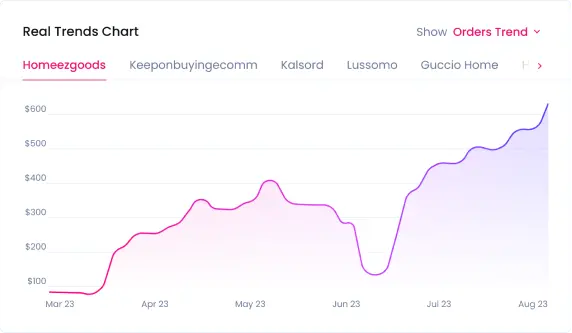How To Find Amazon Dropshipping Products in 2025: Best Sellers
Contents
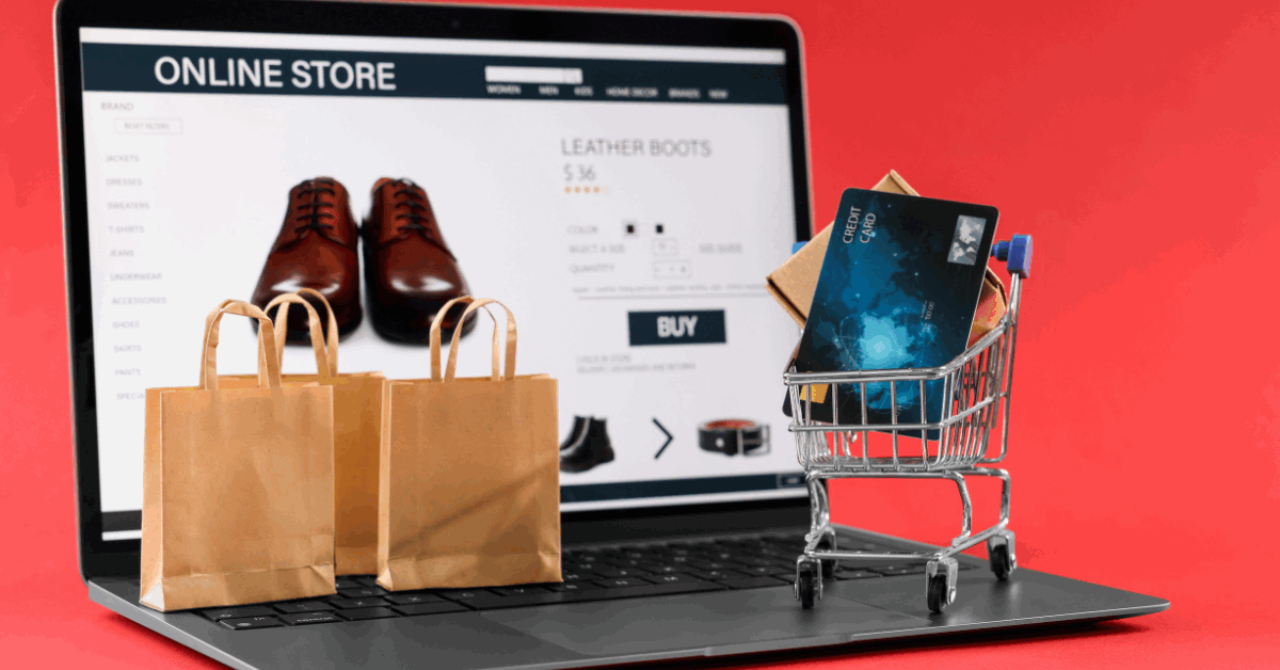
Finding good Amazon dropshipping products in 2025 isn’t magic. It’s a skill — and a simple one once you know what to look for.
There’s no need to chase every new trend. No need to spend hours lost in random product lists either.
Instead, you just need a smart way to spot what’s already working — and catch it before everyone else does
This guide will show you how. Step by step. No guessing. No wasting time.
If you’re tired of hoping your next product will be “the one,” and you’re ready to build something that sells, you’re in the right place.
Let’s dive into the real way to find best-selling Amazon dropshipping products in 2025 — and finally get ahead of the game.
Key Takeaways
- Focus on high-demand, lower competition products like fashion accessories, pet beds, and cleaning supplies to boost dropshipping success and maximize profit potential.
- Use tools like Sell The Trend to spot trending items early across Amazon, AliExpress, and Shopify, and make smarter decisions without relying only on search engines.
- Always prioritize product quality, work with reliable dropshipping suppliers, and focus on providing an excellent customer experience to build brand loyalty and drive repeat sales.
- Combining manual research with platforms like Sell The Trend helps independent sellers find profitable products faster, whether through traditional sourcing or online arbitrage opportunities.
- Managing advertising costs smartly, focusing on providing significant value, and adapting to real-time customer needs will help drive sales and outperform other sellers in a growing global market.
What Makes A Great Amazon Dropshipping Product?
Not every product is a good fit for dropshipping. Some sell fast. Some just sit there. If you want real success, here’s what to look for:
1. High Demand
A great product is something people are already buying. If customers aren’t looking for it, you will struggle to sell it.
High demand means:
- You don’t have to create interest.
- You can tap into existing buying habits.
- Your marketing costs stay lower because people already want the product.
Look for products that have steady sales, not just a sudden spike. Trendy items are good, but reliable demand wins long term.
2. Low to Medium Competition
If a product has too many sellers, it gets harder to succeed. Big brands with hundreds or thousands of reviews will crush small sellers with better prices and faster shipping.
Good products:
- Have some competition (which proves they sell)
- But not so much that you get lost in a crowd
You want enough space to stand out through better listings, better service, or small improvements.
3. Healthy Profit Margins
You’re in business to make money. A great dropshipping product leaves you enough profit after Amazon fees, shipping costs, and returns.
You need to cover:
- Amazon referral fees (about 15% usually)
- Shipping from your supplier
- Refunds and returns
- Advertising (PPC)
After all that, you still need real money left.
4. Lightweight and Easy to Ship
Heavy and bulky products are trouble for dropshipping. They cost more to send, take longer to deliver, and break easily during shipping.
A great product:
- Weighs under 2 kg (around 4.5 lbs)
- Fits easily in standard shipping boxes
- Won’t get damaged easily (no fragile glass, no complicated electronics unless you’re confident)
Light, durable products save you money and make your logistics simple.
5. Solves a Problem or Sparks a Strong Desire
People buy for two main reasons:
- To solve a real problem
- To fulfill a want or emotional need
Problem-solving products make life easier, safer, healthier, or more organized. Example: back braces, organizers, portable blenders.
Desired products make people feel good, stylish, or trendy. Example: jewelry, home decor, fitness accessories.
A great product either improves daily life or gives buyers something they emotionally crave. The stronger the feeling, the faster they buy.
6. Simple and Easy to Understand
Complicated products scare customers away. If it takes more than a few seconds to explain what it is or how it works, it’s a harder sale.
Good dropshipping products are:
- Instantly recognizable
- Easy to show off in a few images
- Simple to describe in one sentence
The easier it is for a shopper to understand, the faster they hit “Buy Now.”
7. Good Quality for the Price
Buyers today expect a lot, even from low-cost products. If your product looks cheap or breaks quickly, expect bad reviews, refund requests, and account problems.
Good products:
- Match or beat customer expectations
- Feel sturdy or well-made
- Deliver better value than the price suggests
In dropshipping, you may not control every part of the supply chain, so picking quality suppliers matters too.
8. No Legal or Trademark Problems
Amazon is strict about copyright, trademarks, and brand violations. If you list fake products, copied brands, or illegal knock-offs, you risk:
- Account suspension
- Lawsuits
- Losing all your earnings
A great product has no logo or brand that belongs to someone else. It’s clean, generic, or properly licensed if needed.
Selling safe, non-branded products keeps your account healthy and your business running smoothly.
9. Room for Extra Sales
Winning products don’t just sell once. They open doors to repeat customers, upsells, or bundles.
Examples:
- A yoga mat → Then sell yoga blocks and straps.
- A phone case → Then offer a matching charger and screen protector.
If your first sale can lead to more products later, you make more money without extra marketing work.
How To Find Amazon Dropshipping Products in 2025
Finding winning Amazon dropshipping products is a skill, not luck. The good news? It’s simple when you know where to look and what to look for.
This step by step guide will show you exactly how to find real product ideas:
1. Use Amazon Best Sellers Lists (The Smart Way)
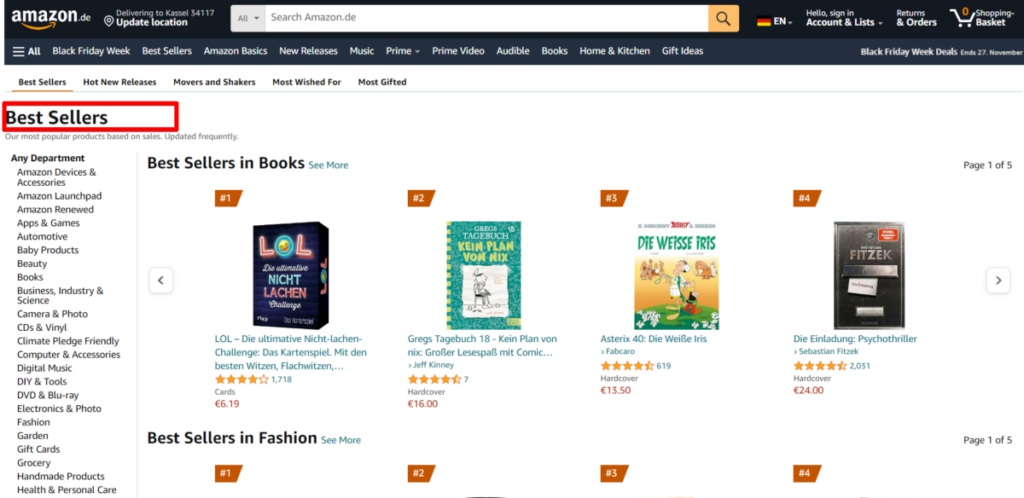
Amazon Best Sellers is one of the easiest places to start your product research. It shows exactly what is selling the most right now, across all categories.
But don’t just look at the top 10 products — that’s what everyone does. The real opportunities are hidden deeper.
Start by picking a main category, like Home & Kitchen, Beauty, or Pet Supplies. Then go inside smaller sub-categories, like “Pet Toys” or “Bathroom Organizers.” These sub-niches are where you’ll find great ideas with less competition.
Focus on products ranked between #20 and #100. These items still sell a lot, but they aren’t dominated by giant brands yet.
Click into listings and study:
- How many reviews? Under 1,000 is better.
- Are the photos professional? If not, you can easily stand out.
- Are descriptions short or messy? If yes, you can beat them with a better copy.
Write down any products that seem simple, useful, and priced between $20 and $70. You’ll need this list for deeper research later.
Amazon already tells you what’s selling. You just need to dig a little smarter than everyone else.
2. Check Amazon Movers & Shakers for Hot Trends
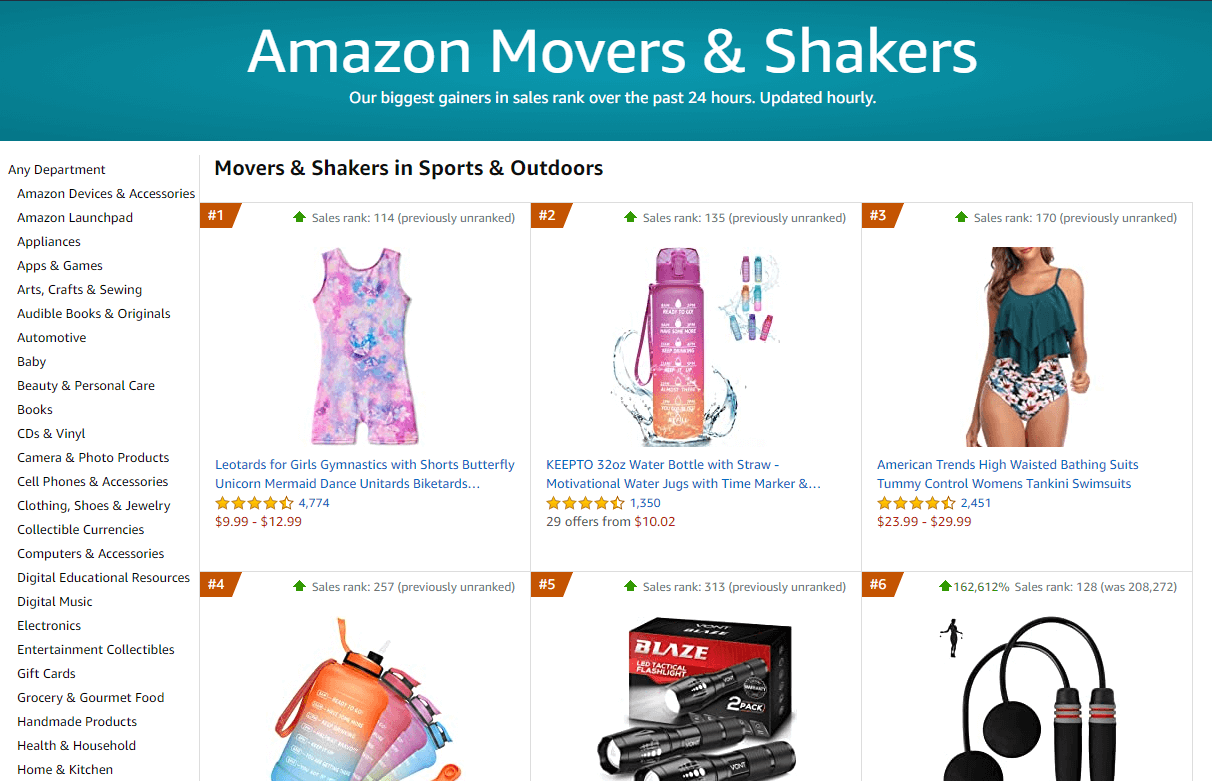
Movers & Shakers is like a sneak peek into the future. It shows the products that had the biggest jump in sales over the last 24 hours.
This is powerful because it helps you catch trends early, before they become crowded.
Here’s how you use it properly:
Go to the Movers & Shakers page, pick a category, and don’t just grab the top item. Study at least 10–20 products that are climbing fast.
When you find a product that is new (launched in the past 6 months) and has under 500 reviews, pay attention. It could be the next big thing.
Check if the product is simple and not a fad that could die in a few weeks. For example, some silly gadgets trend for a week and disappear. Focus on useful products that people would still want even without the hype.
Track these products over a few days. If they keep moving up, they’re real opportunities.
Movers & Shakers isn’t about finding today’s winners — it’s about spotting tomorrow’s. If you jump early, you can dominate before others even notice.
3. Spy on Customer Reviews to Find Gaps
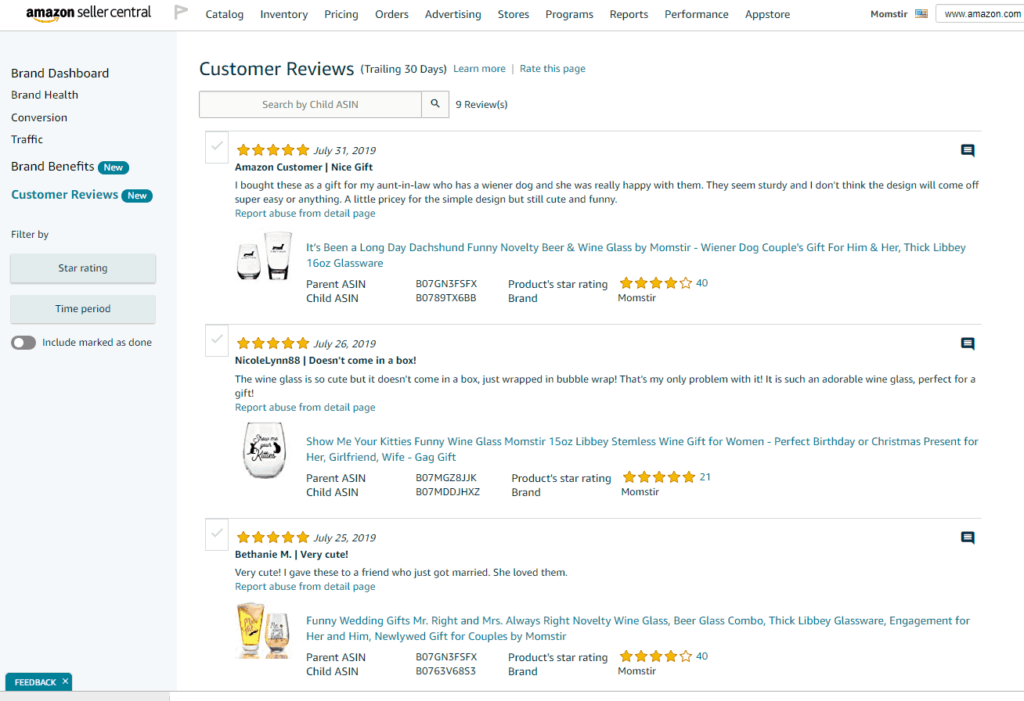
Customer reviews tell you everything. They reveal what people love and what drives them crazy.
Start by picking a product you’re curious about. Scroll straight to the 2-star, 3-star, and 4-star reviews.
These are the sweet spot reviews: not pure hate, not fake love.
Look for repeated complaints or small frustrations. For example:
- “The zipper broke after one month.”
- “The manual was confusing.”
- “The packaging was messy.”
Write down the problems you see over and over again.
Then ask:
- Can I find a better supplier who fixes this issue?
- Can I explain my product better to avoid confusion?
- Can I offer better packaging or instructions?
This is how real product improvements happen. Also, read what people wish the product had:
- “I wish it had more color options.”
- “It would be better if it came with a carrying bag.”
These are free product upgrade ideas. You don’t need to invent a new product. You just need to deliver what customers are asking for — and others are ignoring.
4. Look at TikTok, Instagram, and YouTube Trends
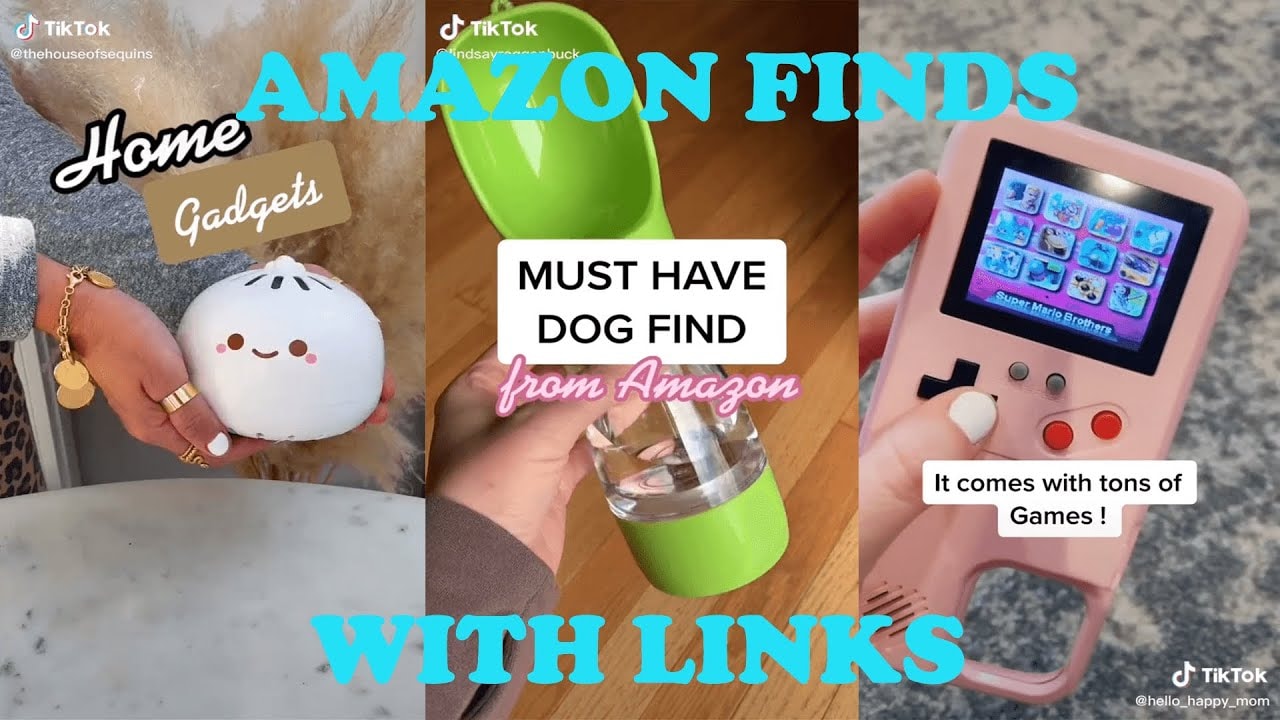
Social media is where trends are born now. Many hot Amazon products go viral here before they even show up in search rankings.
TikTok is gold for this. Search hashtags like:
- #AmazonFinds
- #TikTokMadeMeBuyIt
- #AmazonHaul
Look for videos that got 50 K+ views in less than a week. This shows the product is getting real attention.
When you spot a product, check:
- Are people excited in the comments?
- Are they asking where to buy it?
- Are they sharing the video with friends?
If yes, you’re onto something.
Also, watch YouTube videos titled “Best Amazon Products Under $30” or “Amazon Must Haves 2025.”
People often showcase new ideas here that haven’t yet exploded.
Instagram Reels is another quick hack. Check accounts that focus on unboxing or shopping finds.
Social media tells you what’s coming, not just what’s already here.
Get ahead, not caught behind.
5. Study “Frequently Bought Together” and “Customers Also Bought”

Amazon already tells you what people like to buy together — you just have to look. When a customer views a product, Amazon shows two important sections:
- “Frequently Bought Together”
- “Customers Who Bought This Item Also Bought”
This is valuable data you can use. Here’s how to work it smartly:
- Pick a best-seller in your niche.
- Scroll down to the “Frequently Bought Together” section.
- See what extra products customers are adding.
- These are natural upsells or side products you can sell too.
Also, check the “Customers Also Bought” section. It usually has related but different products. This can help you spot new ideas inside the same niche.
For example, if you are looking at resistance bands, you might find that yoga mats, ankle straps, and storage bags are commonly bought too.
You can either:
- Add these products to your store.
- Bundle them together and offer more value.
The goal here is simple: Follow what buyers naturally want instead of guessing. Amazon already shows you the map — you just have to follow the signs.
6. Use Google Trends To Validate Product Ideas
Before you invest in any product, you need to check if people are searching for it and if the interest is steady. Google Trends is free and powerful for this.
Here’s how you use it right:
- Go to Google Trends.
- Type in the exact product name or a keyword related to it.
- Set the location (like the United States, Germany, the UK, wherever you plan to sell).
- Set the time to “Past 5 Years” — not just “Past 30 Days.”
Look at the graph:
- A flat or rising trend = good.
- A sharp peak with a fast drop = seasonal.
- A constant fall = bad.
For example, a graph that spikes every November (like Christmas decorations) means the product is seasonal. You can still sell it — but you need to prepare early.
If the trend line slowly rises year after year (like home gym equipment after 2020), that’s very good. It means growing demand. See this example:
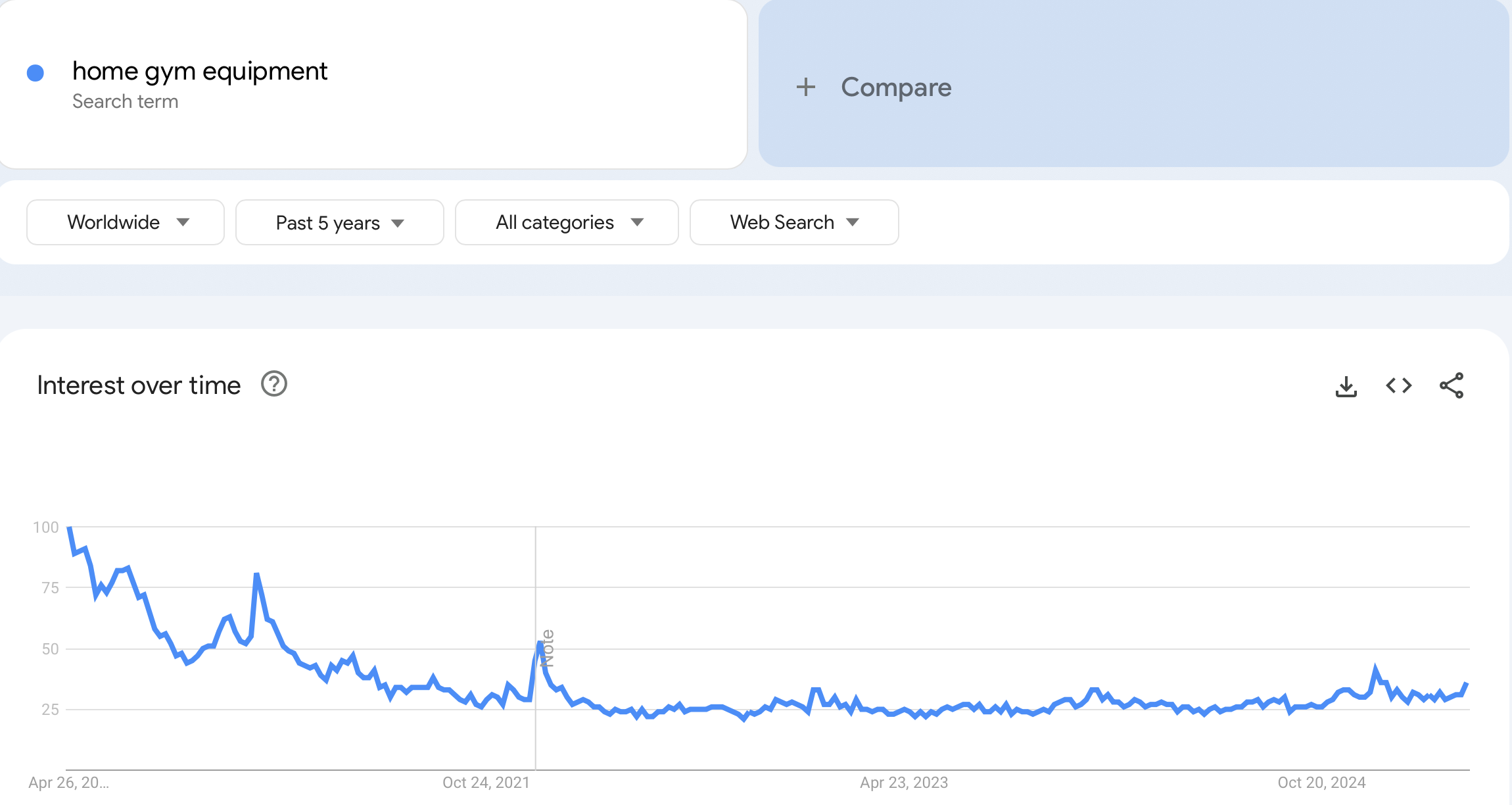
Google Trends stops you from guessing. It shows you if your idea is built for a moment or the long term. Spend five minutes checking before you spend five months regretting.
7. Find Problems in Everyday Life (And Solve Them)
Sometimes the best product ideas are hiding in your day-to-day struggles. The easiest way to find them is to pay close attention to little annoyances.
Here’s how to spot them:
- What tasks annoy you daily?
- What things break, spill, or waste time?
- What do you wish were easier?
For example, If you hate tangled charger cables at your desk, guess what? Tens of thousands of people feel the same.
You can also ask friends and family:
- “What’s something small that annoys you at home or work?”
Another trick: Visit Reddit (look at forums like r/LifeProTips, r/BuyItForLife) or Facebook groups.
See what products people recommend — or complain about.
You’ll find real-life frustrations that need solutions.
Then you find (or improve) a product that solves that pain point. Products that solve real problems sell better — and are easier to market because customers instantly “get it.”
The best products are often not sexy or trendy. They just quietly make life better.
Finding best-selling products manually works great, but it can take a lot of time. If you want to speed up the process, tools like Sell The Trend are extremely helpful.
Sell The Trend pulls trending product data from Amazon, AliExpress, Shopify, and more. It shows you winning products based on real sales trends, customer demand, and store success stories.
Features like the Visual Product Explorer and Trend Research Dashboard make it easy to spot hidden opportunities that most sellers miss. You can even track stores, see what’s selling fast, and filter by profit margins, shipping speed, and supplier rating — all in a few clicks.
Using Sell The Trend alongside manual strategies gives you a major advantage. It helps you move faster, spot winners earlier, and avoid wasting time on products with no future.
3 ( + 1 Bonus) Amazon Tools To Find Best-selling Items
Finding great Amazon dropshipping products by hand is slow. Good tools can speed up the process, show hidden data, and help you make smarter choices.
Here’s a full breakdown of the best tools — and exactly how to use them.
1. Helium 10
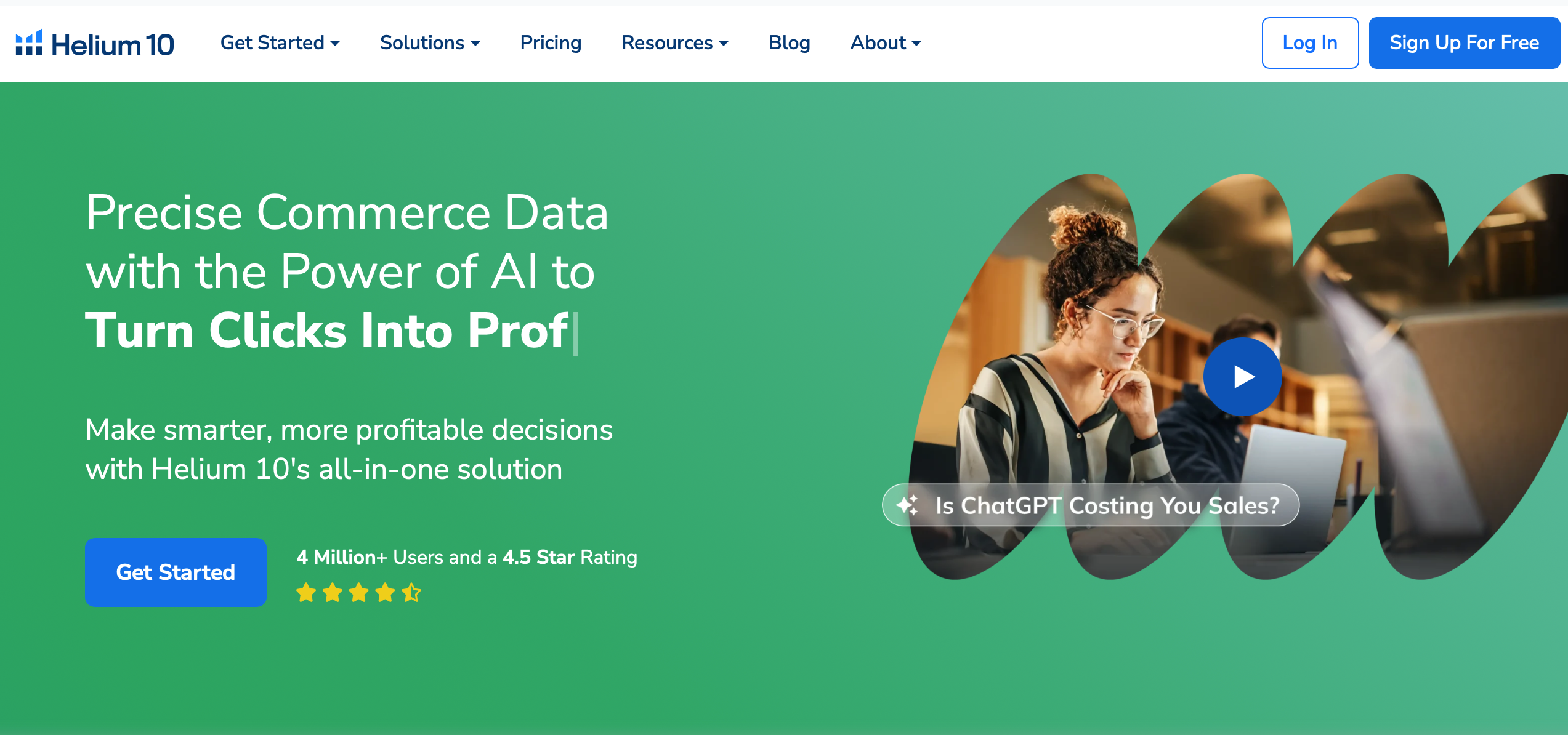
Helium 10 is like a Swiss Army knife for Amazon sellers. It offers many tools inside one platform — product research, keyword research, listing optimization, and profit tracking.
How to use it to find products:
- Open Helium 10 → Go to “Black Box” (Product Research Tool).
- Set filters:
- Price: $20–$70
- Monthly Sales: 300–5,000 units
- Reviews: Less than 500
- Weight: Under 2 lbs
- Hit “Search.”
- You’ll see a list of products that match your criteria.
Next, use Helium 10’s “Trendster” tool:
- Paste a product’s ASIN.
- See if sales are growing, stable, or falling.
Bonus tip: Use “Xray” (browser extension) when browsing Amazon. It shows real-time sales estimates for any product page.
Why it’s great: Helium 10 gives complete control. You find products that fit your exact business plan — not just random trends.
Cost: Free limited version available. Paid plans start around $39/month.
2. Jungle Scout
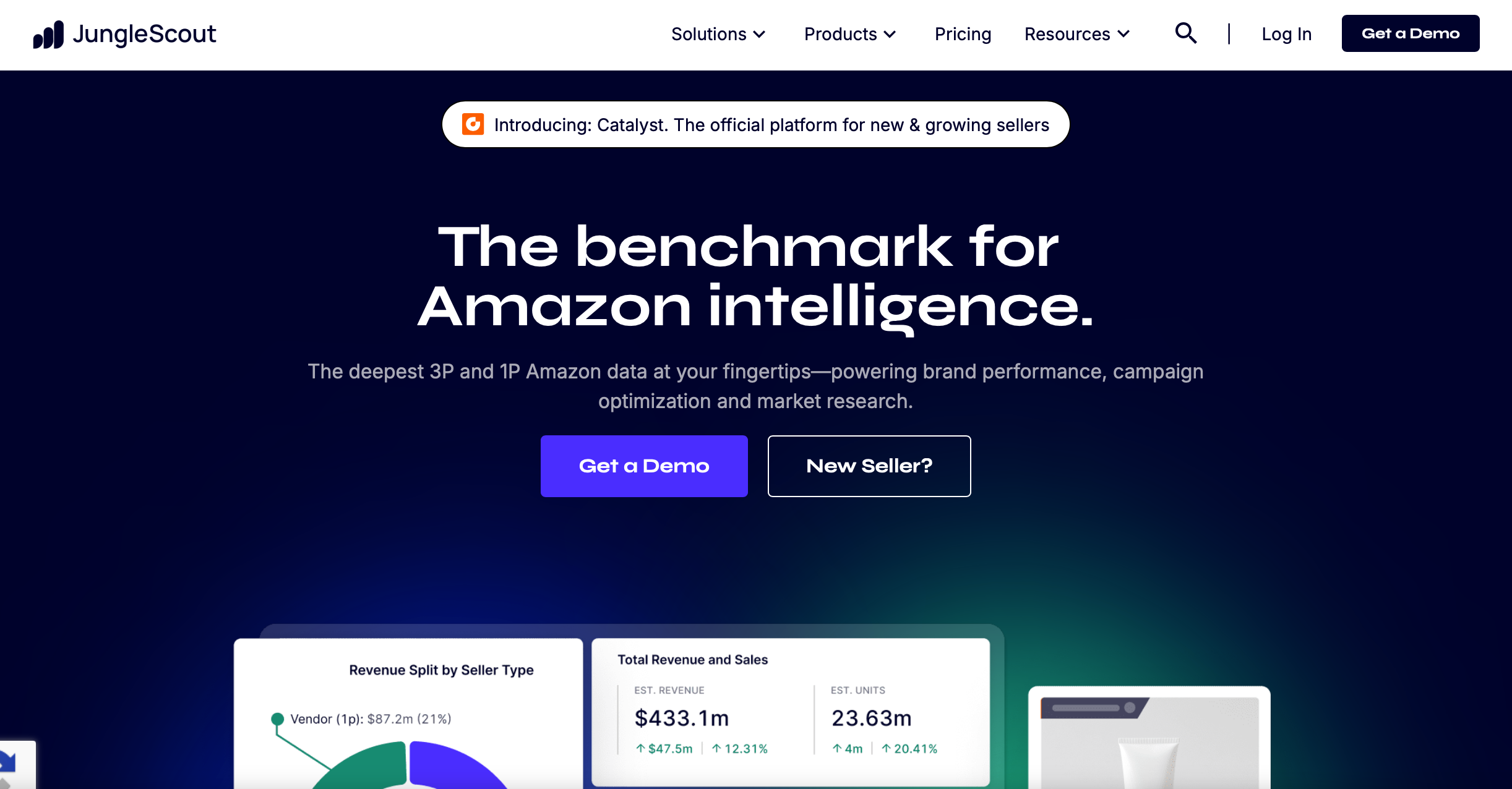
Jungle Scout is one of the most beginner-friendly tools for Amazon sellers. It focuses heavily on product research and market tracking.
How to use it:
- Open Jungle Scout → Use the “Product Database.”
- Set filters:
- Price range: $20–$70
- Sales: 500+ units/month
- Rating: 4 stars or less (for improvement opportunities)
- Reviews: under 300
- Click “Search.”
You’ll find hidden product gems that meet real buying patterns. Next, use Jungle Scout’s “Opportunity Finder”:
- Enter keywords (like “yoga,” “gadgets,” “kitchen”).
- The tool scores niches based on competition, demand, and seasonality.
Bonus tip: Jungle Scout’s “Product Tracker” lets you track products over time. Add interesting items and watch their daily sales for a week before deciding.
Why it’s great: It helps spot not just what’s selling now, but what’s worth selling long-term.
Cost: Starts around $49/month. They also offer 7-day money-back guarantee.
3. AMZScout
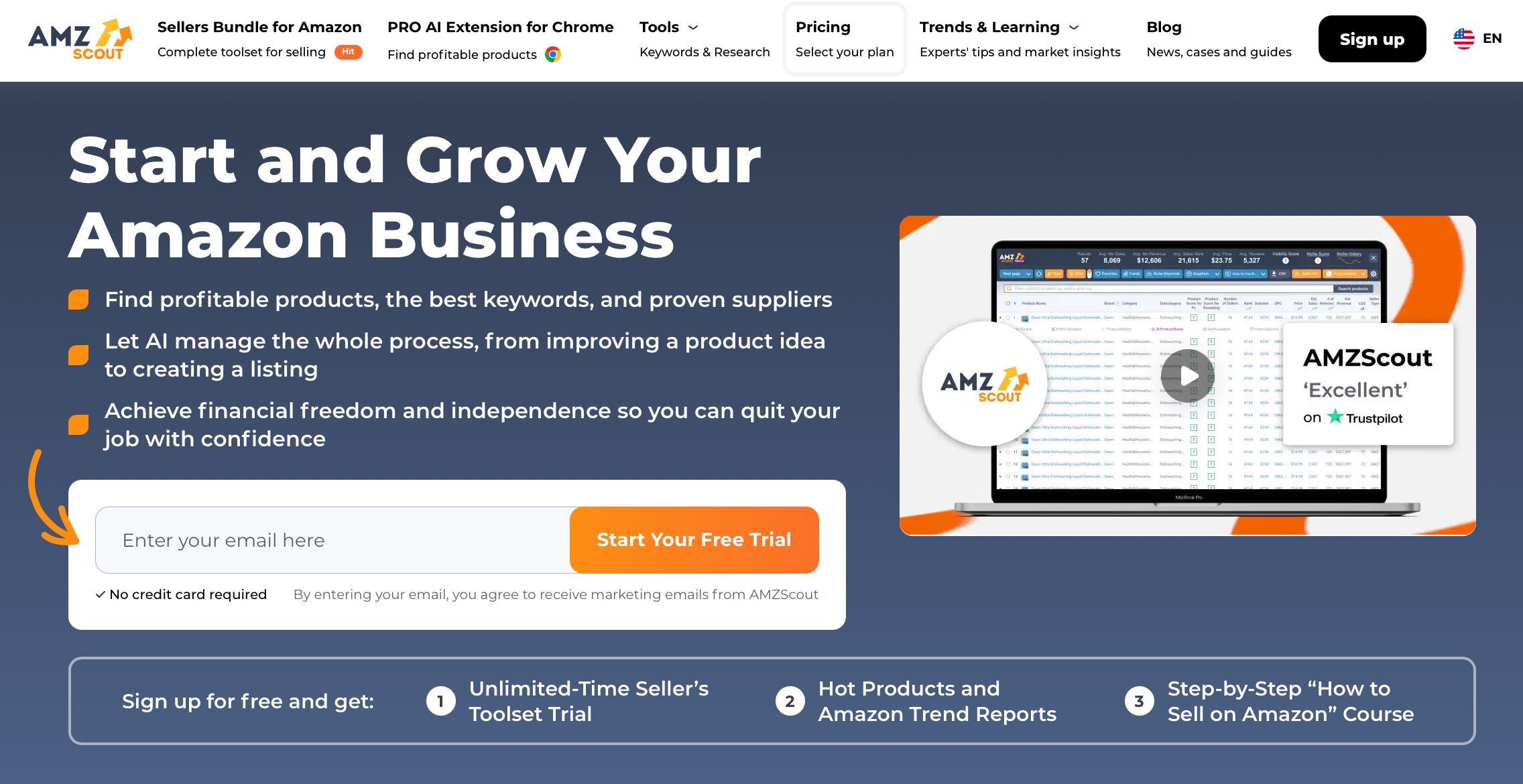
AMZScout is another strong tool, especially good for early-stage sellers. It’s lightweight, simple to use, and very focused on quick product validation.
How to use it:
- Use the AMZScout Pro Extension on Chrome.
- Browse Amazon → Click the Extension when you see an interesting product.
- It shows sales volume, price trends, reviews, and profit margins instantly.
You can also use their Product Database:
- Set your filters (price, weight, reviews).
- Search for hidden product opportunities.
One powerful feature: the “Profit Calculator” built into the extension. You can instantly see if a product will be profitable after Amazon fees and shipping.
Bonus tip: Use AMZScout’s “Product Score.” It rates products based on ease of selling, demand, and competition in one number.
Why it’s great: It’s fast, simple, and affordable for beginners who want speed without complexity.
Cost: Extension starts at a one-time fee (~$179), but they often run discounts.
4. Bonus Tool: Sell The Trend
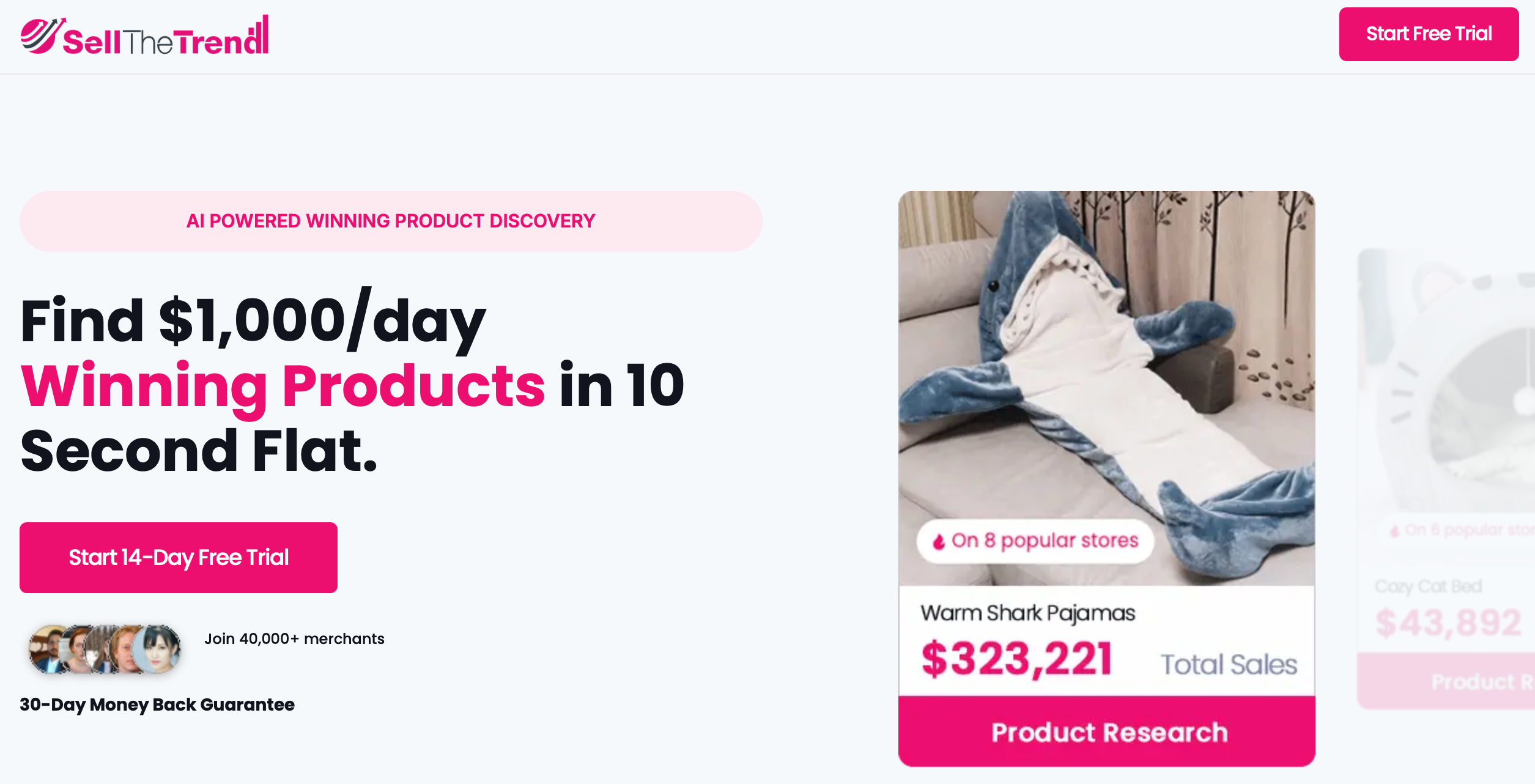
While traditional tools like Helium 10 and Jungle Scout are great for deep research, Sell The Trend is excellent for quickly spotting products that are gaining momentum across different marketplaces.
It gathers live data from Amazon, AliExpress, and Shopify and shows you trends, winning products, and successful stores in just a few clicks.
It’s a helpful shortcut if you want to stay ahead of new trends without spending hours researching manually.
All you have to do is All you have to do is set your filters based on price, niche, shipping options, or marketplace. Sell The Trend will instantly generate a list of products that are already showing strong sales patterns.
You can sort products by how fast they’re trending, how many stores are selling them, and even how saturated the market is.
One of its best features is the Visual Product Explorer, which lets you scan through hundreds of product ideas visually instead of digging through spreadsheets. You can quickly spot fresh, unique items that other sellers haven’t crowded yet.
Another powerful feature is the Store Intelligence tool. It allows you to track winning Shopify stores and see exactly which products are their top sellers. This gives you real examples of what’s working, not just theories.
If you combine Sell The Trend’s trend spotting with the deep analysis tools like Helium 10 or Keepa, you build a powerful system: You find trending products early, and you validate them properly before listing
What are the best products to sell in the Amazon store?
Not every product wins on Amazon. The best items to sell share a few key traits: high demand, healthy profit margins, low competition, and steady year-round interest.
Here’s a list of the best types of products to sell, with clear reasons why each works:
- Home organization products: Items like drawer organizers and closet racks stay in demand year-round because people always want cleaner, tidier spaces.
- Fitness accessories: Lightweight items like resistance bands and yoga mats continue to sell well as more people focus on home workouts.
- Pet supplies: Toys, grooming tools, and feeders are steady sellers because pet owners consistently spend to care for and spoil their pets.
- Personal care and beauty products: Face rollers, scalp massagers, and nail kits are popular because they are affordable and easy ways for people to improve self-care at home.
- Kitchen gadgets: Simple tools like slicers and milk frothers sell strongly because they solve everyday cooking problems quickly.
- Travel accessories: Packing cubes, travel organizers, and portable chargers are lightweight products that stay useful even when travel trends change.
- Health and wellness items: Products like sleep masks, reusable water bottles, and posture correctors are in growing demand as more people focus on health and relaxation.
- Baby products: Baby carriers, bibs, and nursery organizers are essential for parents and often lead to repeat purchases.
- Office supplies: Laptop stands, desk organizers, and planners stay popular as remote work keeps growing across industries.
- Hobby and craft supplies: Paint kits, knitting sets, and DIY tools sell steadily to passionate hobbyists who love creating at home.
Amazon Dropshipping Products: FAQs
1. What Items Can I Dropship On Amazon?
You can dropship almost anything on Amazon if you follow the rules. Most sellers focus on lower priced items that are lightweight and have consistent demand.
Popular categories for a dropshipping business include fashion accessories, tech gadgets, home improvement tools, and kitchen items. Some sellers even explore the global car accessories market because it’s growing fast with strong global market interest.
It’s important to find profitable products with high demand products but not too much competition. Look for significant value without having to compete directly with major brands.
Independent sellers often win by offering better product quality and providing excellent customer service.
If you want to stand out from other sellers, focus on items that are hard to find or bundled in a way that adds extra value. Always choose a reliable dropshipping supplier to avoid delivery problems.
2. Is It Worth It To Dropship On Amazon?
Yes, it can be worth it, but it’s not automatic. The dropshipping model has big potential because you don’t need to hold inventory. However, you face high advertising costs, low profit margins, and strong competition.
Success comes from smart product selection, strong branding, and excellent service. If you can find winning dropshipping products that people want and deliver them quickly, you can build a real dropshipping store.
The key is choosing the right order fulfillment method, working with good suppliers, and offering better service than your competition. You also need to build your brand across social media platforms to drive extra traffic and boost sales.
Amazon is powerful, but remember: brand loyalty usually stays with major brands. New sellers must earn customer trust by offering value and fast service.
3. How Much Does The Average Amazon Dropshipper Make?
There’s no fixed number, but here’s a rough idea. Most beginners make between $200 to $2,000 per month after a few months. Experienced sellers who pick profitable products and manage costs well can scale to $5,000 or more.
Your earnings depend on how well you pick products, manage advertising costs, and handle customer service. Some sellers focus on fashion accessories or smaller niches like the global car accessories market because these can bring steady profits without facing major brands.
If you can lower your expenses and choose high-demand products with healthy margins, you can make good money. Building your own brand over time through social media channels can also push your earnings much higher.
4. How Much Does It Cost To Start Dropshipping On Amazon?
Starting a drop shipping business on Amazon is cheaper than opening a physical store, but you still need a budget.
Here’s what you usually pay for:
- Amazon Professional Seller account: around $39.99/month
- Product research tools (optional but helpful): about $20–$100/month
- First orders or test products, if needed
- Advertising costs like Sponsored Products campaigns
- Branding expenses if you build your dropshipping store
Most people can start with around $500 to $1,500, depending on how aggressive they want to be. Essentially,
If you focus on lower priced items that still deliver significant value, you can keep startup costs lower.
The real investment is time: researching profitable products, choosing a great dropshipping supplier, and mastering social media platforms for free traffic.
If you’re smart about costs and consistent about customer service, dropshipping success becomes much more realistic, even without huge upfront cash.
Conclusion
Dropshipping on Amazon in 2025 is still a smart business model — if you do it right. Focus on finding high demand, profitable products that aren’t heavily affected by seasonal trends, work with trusted suppliers, and always deliver excellent service.
Keep an eye on your product cost to maintain healthy margins and benefit from the low overhead costs that make dropshipping such an attractive way to grow an online business. With smart research, good tools, and a clear plan, you can turn a small start into real dropshipping success.



